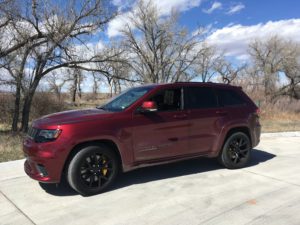
Out east of Greeley one evening, I brought the Jeep to a stop, pushed the “launch” button, held the brake momentarily as I mashed the accelerator and we flew down the paved road for a few seconds before I shut it down. Wow.
It’s the 2018 Jeep Grand Cherokee Trackhawk, equipped with the awesome 707-horsepower Hellcat engine; and built into its launch mode is an automatic timer for 0-to-60 clockings. I don’t do the rush-to-60 much anymore, but since the timer was part of the package, why not. The readout indicated my time was 4.5 seconds.
“That’s really fast,” said Jan, who probably hundreds of times in the past held a stopwatch for timing of similar runs I made (never this fast, though).
Regarding the 4.5 reading for the Trackhawk, though, I knew I hadn’t fully depressed the pedal at launch, and, such a quiet evening with absolutely no traffic around, I said, “Let’s try it one more time.”
This time, the Trackhawk was ready, I was ready, and the result was very satisfactory – 3.9 seconds.
Not often, in recent years, have I checked cars and trucks for 0-to-60 times. Years back, Jan was my official timer with the stop watch; we would test them 0-to-50. I’d yell “Go” as I kicked down the accelerator and Jan started the watch, then as the needle moved past 50, “Okay” was the signal for Jan to shut the watch off.
Not as precise as the automatic timer in the Trackhawk, but the method served as a rough indicator of one vehicle’s quickness compared with another. The ’98 Dodge Viper, ’99 Porsche 911 Carrera and ’09 Nissan GT-R were close to 4 seconds (remember, that was to 50, not 60). Others with quickness were an ’81 Maserati Merak SS, ’93 Toyota Supra, ’02 BMW M3 Coupe, ’02 Vette ZO6, ‘03 Audi RS6, ’03 Ford Mustang Mach 1, ’09 Bentley Continental GT, and others I’ve forgotten.
The slowest ever was a ’91 Geo Metro convertible with a 1-liter, 3-cylinder engine, automatic transmission, 19.06 seconds.
The Jeep Trackhawk has beneath its hood the same 6.2-liter Hemi V-8 best-known for performances in
Dodge Challengers and Chargers. It is the first Chrysler factory-produced Hemi engine powered by a supercharger, rather than a turbocharger. I had no occasion to test it for a top speed; Jeep officials say it will reach 180 miles per hour. Its speedometer registers to 200.
Jan and I in the Trackhawk on a Sunday morning headed south in to Denver and, in heavy traffic, drove slowly past Coors Field, where hundreds of baseball fans were already lined up, ostensibly in pursuit of Colorado Rockies star Charlie Blackmon bobbleheads. That was the giveaway for the Colorado Rockies game against the Atlanta Braves.
On down 22nd Street, we pulled into the parking lot beside Soneff’s automotive building. A few years back, I occasionally saw the late John Soneff out there collecting 5-dollar-bills for parking. Now, it’s a digital machine, which requests first, a license plate number, then partially swallows a credit card which is $20 lighter when it spits it back out. After a short walk, we, too, had a Blackmon bobble in our hands.
Adding impressive performance parameters to the Trackhawk is German-built ZF 8-speed automatic transmission tied to the powerful 6.2-liter Hemi V-8 with 645 lb.-ft. of torque, beefed-up QuadraTrac four-wheel-drive system, Bilstein competition suspension and huge 15.75-inch brake rotors with Brembo 6-piston calipers. Those calipers, by the way, are bright yellow. “My preference is still the comfortable Grand Cherokee Limited at much less cost,” said Jan.